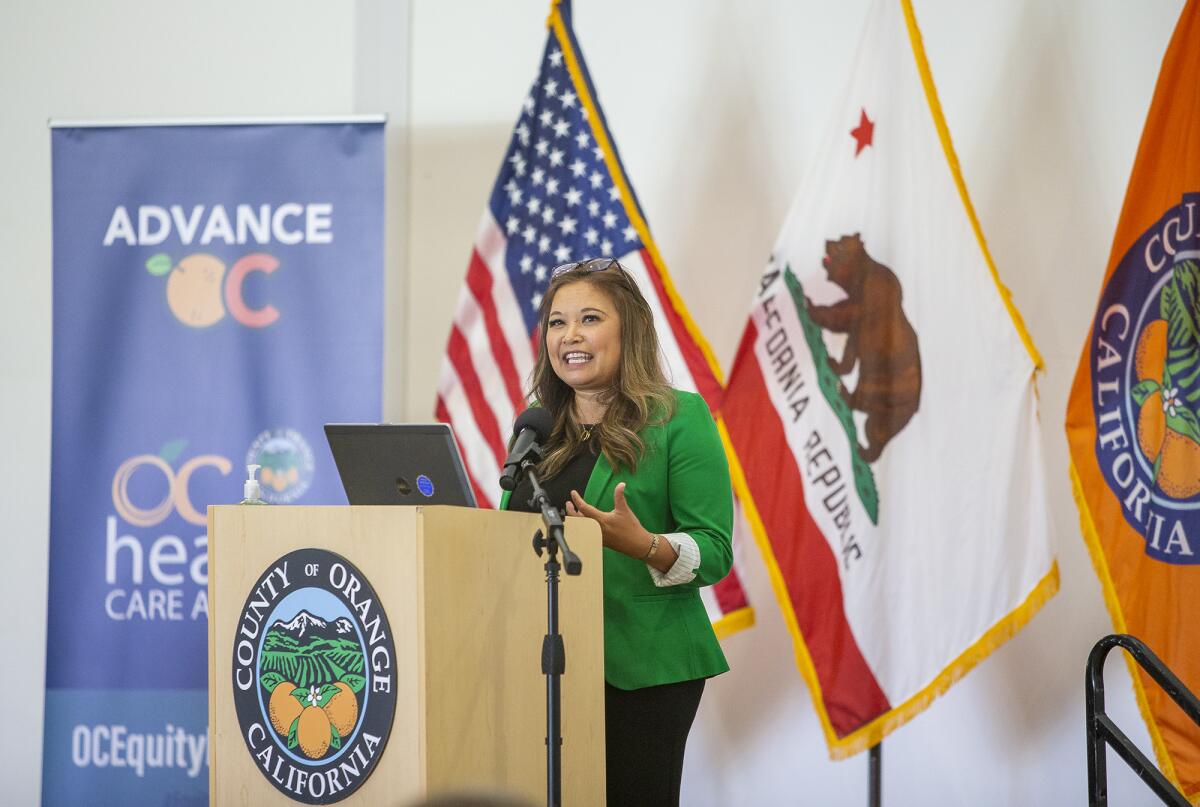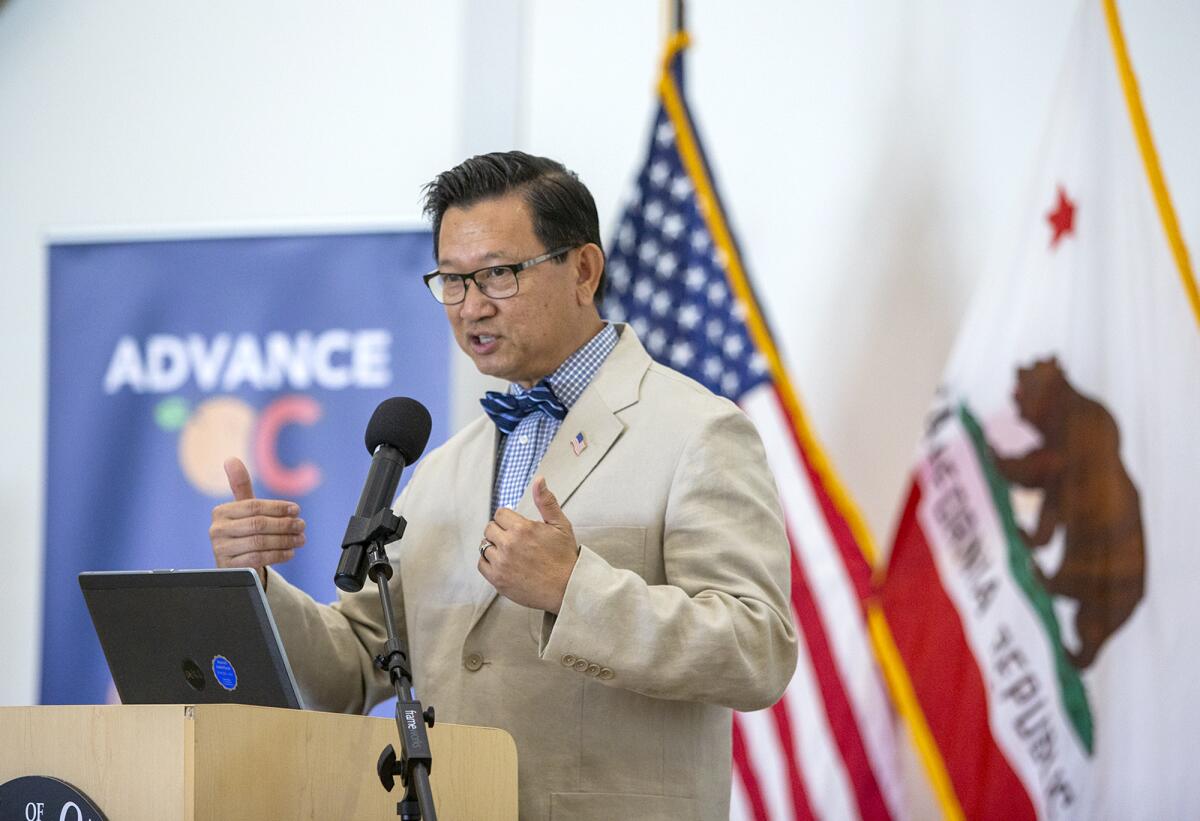Orange County to utilize new equity map to help resolve community disparities
- Share via
In an effort to fix social and health inequities revealed and worsened by the COVID-19 pandemic, a local nonprofit has partnered with Orange County to develop a map equity tool that shows which cities and neighborhoods are the most in need.
The Orange County Equity Map could allow the county, cities and nonprofits to better allocate resources to communities that suffer from issues like poor education, hunger, substandard environmental conditions and lack of affordable housing.
The map tool, which was released last month, was developed by Advance OC, a nonprofit that was started in 2019 with the goal of working toward ending social and health disparities in the county.
“The goal of doing an equity map is really to factor in those historical inequities that exist in structural elements in our community — where folks have disproportionately lacked resources in the past and how that has manifested into different lived experiences by our community members,” said Katie Kalvoda, president and board chair of Advance OC. “So we wanted to be able to create a tool that could visualize that for folks and then help be a resource.”
The equity mapping tool tracks various information, including health disparities and social and environmental inequities. The map has data on access to nutrition and supermarkets, the percentage of the population that uses dental care, water quality, safety and crime, opportunity and residential segregation, among many others.
Advance OC pairs the mapping tool with indexes on social progress and COVID-19 vulnerability. Santa Ana, Stanton, Garden Grove, Anaheim, Westminster, Buena Park, La Habra, Costa Mesa, Fullerton and Orange score the lowest on the social progress index, which takes into consideration issues like basic human needs, housing, personal safety, health and wellness, inclusiveness and personal freedom and choice.
The data could possibly be used to help advance housing affordability and help alleviate homelessness, as well as close education gaps for children. For instance, the map reveals the neighborhoods with the least broadband availability. This digital divide has become all the more important as distance learning became the norm last year, requiring students to have access to the internet to virtually attend school. In response to this data, school districts can better understand the factors that play a role in student achievement gaps in a community.

“We want to be able to help everyone who’s trying to advance Orange County,” Kalvoda said. “Our value statement is basically that we believe that no one should be held back by their Zip code, they should all have an opportunity to live and thrive and reach their human potential, regardless of where they live.”
The Orange County Health Care Agency has already used the map to determine where it should perform vaccine outreach. Karin Kalk, director of project management and quality improvement at the agency, said in an interview that the county deployed mobile vaccination units to the neighborhoods and census tracts that were most in need of the vaccine.
Kalk said the county will use the map to help guide its allocation of a $22.8-million grant from the Centers for Disease Control and Prevention, which is meant to be used for COVID-19-related health disparities. The county will also be forming a coalition guided by the map to help solve high-priority COVID-19-related needs in the community.
“We were able to find the neighborhoods that had the greatest risk for COVID, we knew we needed to do extra work to make sure vaccines were reaching those communities,” Kalk said.
Kalvoda said the map also empowers residents with the information they need to better advocate for change in their neighborhoods. The public can use the data on the website to validate their advocacy, she said.
“A lot of folks for years and years have been trying to advocate for their communities, and sometimes people are very dismissive,” Kalvoda said. “For example, when they come to a city council meeting and talk about poor water quality or lack of broadband access for their kids, or whatever the case may be, people sometimes are dismissive. They can bring the data to their city council members and city managers and say, ‘See, this is what I’ve been talking about all these years.’”
Hieu Nguyen, the county’s director for the Office of Population Health and Equity, said residents can type their addresses into the map tool and see the equity issues associated with their neighborhoods. Nguyen said he can imagine community members taking this information to their local governments to ask informed questions and advocate for change.
“That imagery has stuck with me as to why we want this data to exist and be utilized by the community,” Nguyen said.
The data in the map and index comes from various national, state and local sources provided by different Orange County agencies and nonprofits, the CDC, the U.S. Census and others. Kalvoda said the nonprofit created the idea for the map, then worked with the nonprofit Social Progress Imperative to help gather and analyze the data in the map. The Social Progress Imperative produces a well-known list of equity data called the Social Progress Index that’s been used by the state of California, the United Nations and foreign countries. Advance OC will continue to update the map as new data becomes available.
Though the equity map was released in mid-July, Kalvoda said a lot of people have already been reaching out to Advance OC to partner on projects relating to homelessness, education inequity and food insecurity. She said she couldn’t reveal what groups or people the nonprofit has been in contact with.
Advance OC was able to complete the map with the help of $387,000 from the county, which was approved by the county Board of Supervisors about a year ago at the urging of Supervisors Andrew Do and Doug Chaffee.
Do said over the phone that the county will now be able to better target resources it allocates to communities in need.
“The goal is for us in the system, whether it be the government or agencies, to be able to speak a common language,” Do said. “So when we look at the indicators as to the well-being of our communities, we speak the same language, we look at the same set of data, from which we measure performance. People define equity differently, and they look at different things, and so it is really hard for policy decision-makers to agree on possible causes and results of policy issues that they are trying to address.”

Echoing Do’s sentiments, David Gillanders, executive director of Pathways of Hope, said the map can help nonprofits like his determine which areas in the county to focus services. Pathways of Hope provides more than 200,000 meals and thousands of pounds of food each year to northern Orange County residents who face food insecurity. The nonprofit also provides housing and support services to the homeless, including leading the first safe parking program in the county.
But while the map provides valuable information, it won’t mean much if action isn’t taken, officials and advocates say.
“Information without action doesn’t mean enough,” Gillanders said. “When I look at something like the equity map and I think, gosh this is a great amount of information, but if we don’t take action to address these things from leadership, from local government and the nonprofits to really dive deep and utilize this information and work to solve problems, then just having information is not enough.”
Tracy La, executive director of VietRISE, also believes that “action is what is going to create equity, not just a data pool.” VietRISE is a social justice nonprofit that advocates for working-class Vietnamese and immigrant communities in Orange County.
La took issue with the map tool and stated that it isn’t an equity tool by itself because an equity tool needs more context than just data. It has to tell the story behind the data, she said.
“I think naming it an equity tool is misleading,” La said. “It doesn’t have an equity framework — like partnerships with nonprofits or activist groups working on advancing equity and justice — and it doesn’t explicitly share how it’s advancing equity because providing data alone without a call to action can’t do that. The data also comes from other tools that activities and nonprofits already use. The tool could be helpful, but it is limited.
“Our Board of Supervisors should be committing to achieving systemic change and passing policies that make life easier on a structural level for working-class and marginalized communities if they really want to advance equity. Historically they have not been receptive about policies that will increase housing affordability, end homelessness and evictions, address over-policing, etc. Anything on equity needs to also clearly have a race and immigration lens — how undocumented immigrants face these issues differently — which this tool doesn’t have.”
All the latest on Orange County from Orange County.
Get our free TimesOC newsletter.
You may occasionally receive promotional content from the Daily Pilot.




